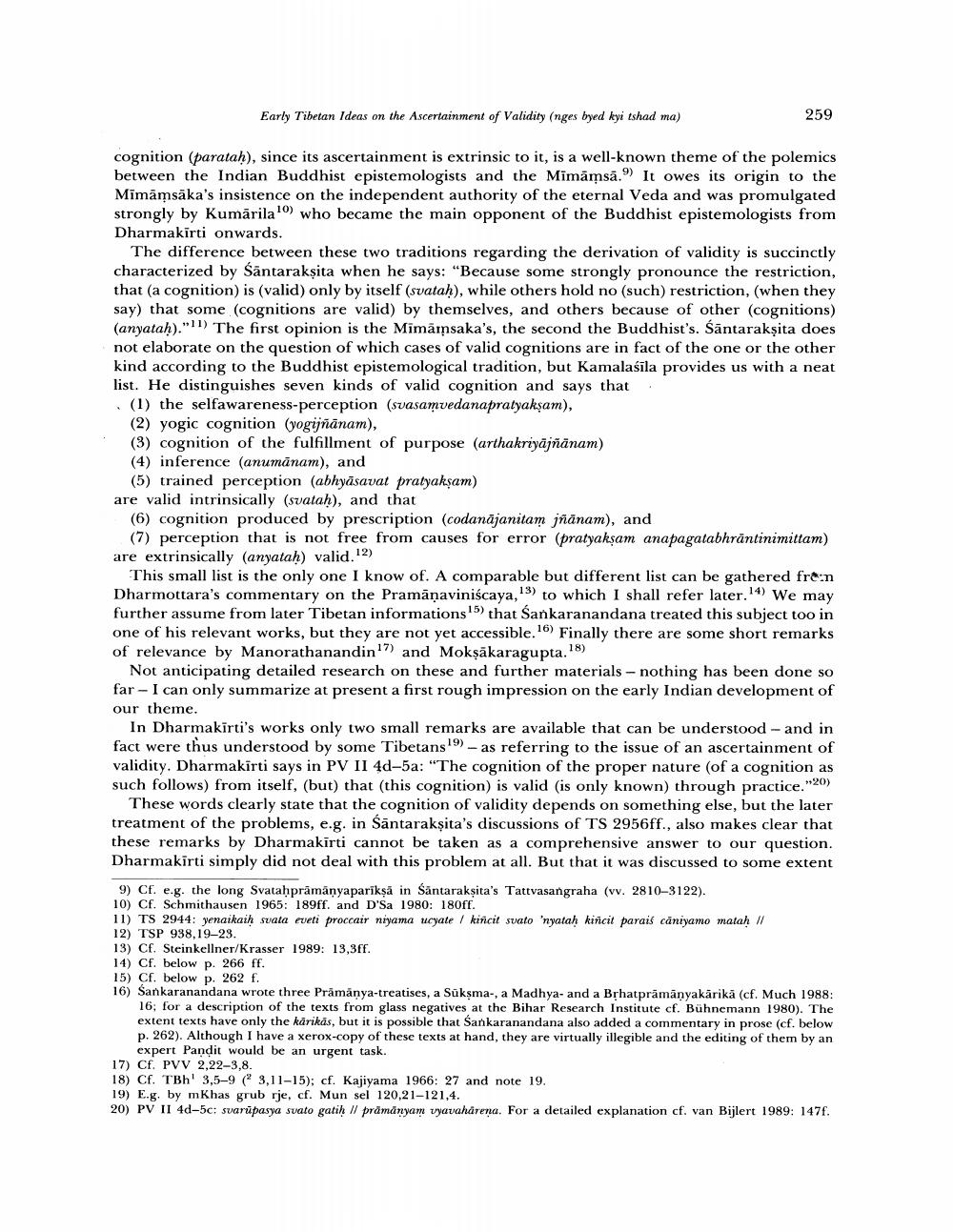Book Title: Early Tibetan Ideas On Ascertainment Of Validity Author(s): Ernst Steinkellner Publisher: Ernst Steinkellner View full book textPage 3
________________ Early Tibetan Ideas on the Ascertainment of Validity (nges byed kyi tshad ma) 259 cognition (paratah), since its ascertainment is extrinsic to it, is a well-known theme of the polemics between the Indian Buddhist epistemologists and the Mimāmsä. It owes its origin to the Mimāmsāka's insistence on the independent authority of the eternal Veda and was promulgated strongly by Kumarila'') who became the main opponent of the Buddhist epistemologists from Dharmakirti onwards. The difference between these two traditions regarding the derivation of validity is succinctly characterized by Säntarakṣita when he says: "Because some strongly pronounce the restriction, that (a cognition) is (valid) only by itself (svatah), while others hold no (such) restriction, (when they say) that some (cognitions are valid) by themselves, and others because of other (cognitions) (anyatah).")) The first opinion is the Mimāımsaka's, the second the Buddhist's. Sāntarakṣita does not elaborate on the question of which cases of valid cognitions are in fact of the one or the other kind according to the Buddhist epistemological tradition, but Kamalasila provides us with a neat list. He distinguishes seven kinds of valid cognition and says that (1) the selfawareness-perception (svasamvedanapratyakşam), (2) yogic cognition (yogijñānam), (3) cognition of the fulfillment of purpose (arthakriyajñānam) (4) inference (anumānam), and (5) trained perception (abhyāsavat pratyakşam) are valid intrinsically (svatah), and that (6) cognition produced by prescription (codanäjanitam jñanam), and (7) perception that is not free from causes for error (pratyakşam anapagatabhrāntinimittam) are extrinsically (anyatah) valid.12) This small list is the only one I know of. A comparable but different list can be gathered frein Dharmottara's commentary on the Pramāņaviniscaya,13) to which I shall refer later. 4) We may further assume from later Tibetan informations15) that Sankaranandana treated this subject too in one of his relevant works, but they are not yet accessible.16) Finally there are some short remarks of relevance by Manorathanandin") and Mokşākaragupta.18) Not anticipating detailed research on these and further materials -nothing has been done so far - I can only summarize at present a first rough impression on the early Indian development of our theme. In Dharmakīrti's works only two small remarks are available that can be understood - and in fact were thus understood by some Tibetans19) - as referring to the issue of an ascertainment of validity. Dharmakirti says in PV II 4d-5a: "The cognition of the proper nature (of a cognition as such follows) from itself, (but) that this cognition) is valid is only known) through practice."20) These words clearly state that the cognition of validity depends on something else, but the later treatment of the problems, e.g. in Santarakṣita's discussions of TS 2956ff., also makes clear that these remarks by Dharmakirti cannot be taken as a comprehensive answer to our question. Dharmakirti simply did not deal with this problem at all. But that it was discussed to some extent 9) Cf. e.g. the long Svatahprāmanyapariksă in Santaraksita's Tattvasangraha (vv. 2810–3122). 10) Cf. Schmithausen 1965: 189ff. and D'Sa 1980: 180ff. 11) TS 2944: yenaikaih svata eveti proccair niyama uyate / kincit svato 'nyatah kiñcit parais caniyamo matah // 12) TSP 938, 19–29. 13) Cf, Steinkellner/Krasser 1989: 13,3ff. 14) Cf. below p. 266 ff. 15) Cf. below p. 262 f. 16) Sankaranandana wrote three Prämánya-treatises, a Suksma-, a Madhya- and a Brhatprämänyakärikä (cf. Much 1988: 16; for a description of the texts from glass negatives at the Bihar Research Institute cf. Bühnemann 1980). The extent texts have only the kärikäs, but it is possible that Sankaranandana also added a commentary in prose (cf. below p. 262). Although I have a xerox-copy of these texts at hand, they are virtually illegible and the editing of them by an expert Pandit would be an urgent task. 17) Cf. PVV 2,22–3,8. 18) Cf. TBh' 3,5-9 (3,11-15); cf. Kajiyama 1966: 27 and note 19. 19) E.g. by mKhas grub rje, cf. Mun sel 120,21-121,4. 20) PV II 40-5c: svarūpasya svato gatih // pramanyam vyavahärena. For a detailed explanation cf. van Bijlert 1989: 147f.Page Navigation
1 2 3 4 5 6 7 8 9 10 11 12 13 14 15 16 17
